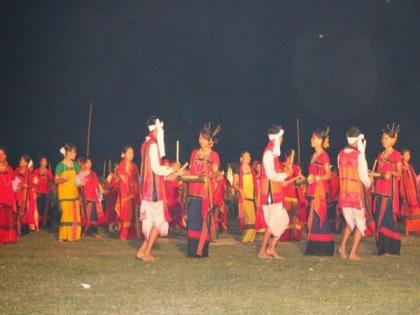Northeastern tribe Chakma's dance is blend of Buddhist spirituality, indigenous tribal customs
By ANI | Published: April 17, 2023 10:30 PM2023-04-17T22:30:28+5:302023-04-17T22:35:02+5:30
New Delhi [India], April 17 : Chakma, an indigenous tribe which primarily resides in the northeastern states of Tripura, ...

Northeastern tribe Chakma's dance is blend of Buddhist spirituality, indigenous tribal customs
New Delhi [India], April 17 : Chakma, an indigenous tribe which primarily resides in the northeastern states of Tripura, Mizoram, and Assam is known for its unique blend of Buddhist spirituality and traditional customs.
The Chakma people hold onto their ancient cultural heritage with grace and pride, according to a report.
Their traditional dance forms serve as a bridge between their spiritual heritage and tribal identity. This feature piece delves into the vibrant world of Chakma dance, its Buddhist roots, and its significance in preserving the tribe's cultural identity.
The Chakma tribe has a rich and diverse history that traces back centuries, with their origins deeply rooted in the region of present-day Bangladesh.
"They are one of the few tribes in North East India that have adopted Buddhism as their primary faith, which sets them apart from the predominantly mistic tribal communities in the region. This blend of Buddhism and indigenous customs has shaped their distinct cultural identity, creating a unique mosaic of tradition and spirituality," the report said.
Chakma traditional dances are an integral part of their cultural and spiritual expression. Two of the most prominent dance forms are the Bizhu dance and the Raja dance. These dances are performed during festivals and special occasions, offering a glimpse into their spiritual heritage and a celebration of their cultural roots.
The Bizhu dance is performed during the Bizhu festival, which marks the beginning of the Chakma New Year. This dance is characterized by its graceful, fluid movements and vibrant attire. Women wear traditional hand-woven sarongs called "pinons" and adorned with colorful jewelry, while men wear "dhutis" and turbans. Accomped by the soothing melodies of flutes, drums, and cymbals, the dancers move in harmony, symbolizing the interconnectedness of life and the cosmos, the report said.
"The Raja dance, on the other hand, is performed to honor the Chakma king, who holds a central role in the community's socio-cultural life. This dance form showcases the martial prowess of the Chakma warriors, with participants wielding swords and shields as they perform acrobatic feats and demonstrate their combat skills. The Raja dance serves as a reminder of their storied past and the importance of maintaining their cultural heritage," it added.
However, the Chakma people face the challenge of preserving their unique cultural identity in the globalizing world.
"The traditional dance forms play a crucial role in this endeavour, as they offer a tangible connection to their spiritual heritage and tribal customs. The younger generations are encouraged to learn and participate in these dance forms, ensuring that the essence of Chakma culture is carried forward," the report said.
"The dance of the Chakmas in North East India is a mesmerizing blend of Buddhist spirituality and indigenous tribal customs. It serves as a testament to the resilience and adaptability of their culture, as they continue to preserve and celebrate their unique identity in a rapidly changing world," it added.
Disclaimer: This post has been auto-published from an agency feed without any modifications to the text and has not been reviewed by an editor
Open in app